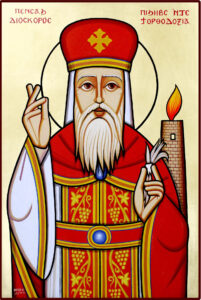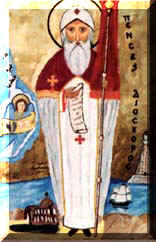St. Dioscoros, Patriarch of Alexandria – Sep 4

Mar Dioscorus, was born, in Alexandria, in Egypt. Other details of his birth, parenthood, childhood, education is not available. Dioscoros served as the dean of the Catechetical School of Alexandria, and was the personal secretary of St. Cyril of Alexandria, whom he accompanied to the Council of Ephesus in 431. He eventually rose to the position of archdeacon. He served as Archdeacon to his predecessor, St. Coorilos (Cyril), whom Church commemorates St Cyril in the 5th Thubden, as the father of true faith, who taught true belief of the Church, about the Incarnation of Christ. Dioscorus attended the Synod of Ephesus after the demise of St. Coorilos, he was consecrated the Patriarch of Alexandria in A.D. 444. Mar Dioscorus is considered a saint and an orthodox confessor by the Coptic, Syriac, and other Oriental Orthodox Churches.
Dioscorus was an outspoken opponent of Nestorianism and proponent of the view that Christ’s humanity and divinity must be regarded as united in “one nature.” He supported the cause of the monk Eutyches, who had been condemned at Constantinople for his Monophysite views, against the heresy that Jesus born of Mary possessed two natures after the miraculous union, was condemned by this synod. This synod decided not to move away from the decision reached by all other universal synods. Dioscorus possessed letters of Church fathers like Mar Athanasius, Gregory and Coorilos to prove that Jesus who attained the human form after the union has only one nature and it was wrong to say he had dual nature. Dioscorus faced many tribulations as he refused to divert from the teachings of ancient Church fathers about Christ and Blessed Virgin Mary.
There was a schism following the decision of the A.D. 449 synod, among the members of monastery, prelates and administrators about the dual nature of Christ. As this dispute reached its height Emperor Theodosius died on 28 July A.D. 450 without leaving an heir. His sister Pulcheria was a nun. The prelates of the Nestorian congregation who desired the support of the rulers allowed her to marry. She married Marcian and ascended the throne as the queen.
The emperor and empress Pulcheria were irritated at this, and the empress commanded to smite St. Dioscorus on his mouth, and to pluck out the hair of his beard. He took the hair and the teeth that were knocked out and sent them to Alexandria saying, “This is the fruit of Faith”. He was compelled by Yuhanon, the Marcian’s commander, to sign the decisions of the Chalcedon synod. The saint refused “Even if my hand is severed and blood flows over the paper, I will not sign it.” Then according to the orders of enraged emperor Marcian, he was banished to Gangra (now Cankri, Turkey), along with St. Macarius, the Bishop of Edko, and two others, and the Council of Chalcedon was resumed. Dioscorus knew, he too might be banished like those fathers, but he was not ready to give up their teaching. He fought for the true faith at the Synod of Chalcedon in 451.

When they took St. Dioscoros to the island of Gangra, its Nestorian bishop, met him with contempt and disdain. But God performed at the hands of St. Dioscoros many great signs and wonders, so that all obeyed him, respected and revered him greatly, for God honors His chosen ones in every place. St. Dioscoros told St. Macarius, his companion in exile, “You shall receive the crown of martyrdom in Alexandria.” He sent him, with one of the believing merchants to Alexandria, where he received the crown of martyrdom. St. Dioscoros, having ended his good fight, departed from this earthly life, and received the crown of eternal life. He passed away on 4 September A.D. 454 when he was there. He is remembered in the fifth diptych (Thubden) and his memory is commemorated on 4 September.
May his blessings and prayers be with us all. Amen.

0 Comments